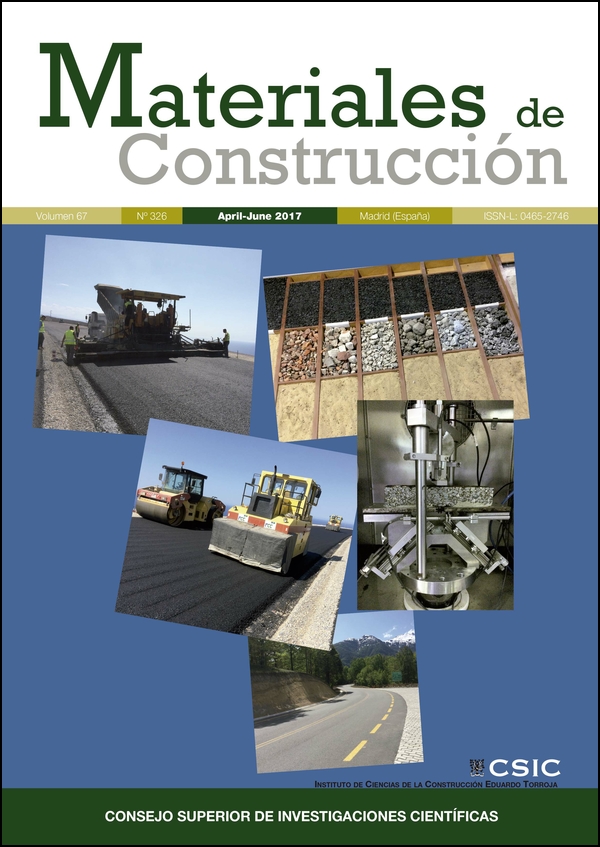Post-cracking tensile behaviour of steel-fibre-reinforced roller-compacted-concrete for FE modelling and design purposes
DOI:
https://doi.org/10.3989/mc.2017.06716Keywords:
Concrete, Composite, Fibre reinforcement, Metal reinforcement, Waste treatmentAbstract
Fracture of steel-fibre-reinforced-concrete occurs mostly in the form of a smeared crack band undergoing progressive microcracking. For FE modelling and design purposes, this crack band could be characterised by a stress-strain (σ-ε) relationship. For industrially-produced steel fibres, existing methodologies such as RILEM TC 162-TDF (2003) propose empirical equations to predict a trilinear σ-ε relationship directly from bending test results. This paper evaluates the accuracy of these methodologies and their applicability for roller-compacted-concrete and concrete incorporating steel fibres recycled from post-consumer tyres. It is shown that the energy absorption capacity is generally overestimated by these methodologies, sometimes up to 60%, for both conventional and roller-compacted concrete. Tensile behaviour of fibre-reinforced-concrete is estimated in this paper by inverse analysis of bending test results, examining a variety of concrete mixes and steel fibres. A multilinear relationship is proposed which largely eliminates the overestimation problem and can lead to safer designs.
Downloads
References
ACI 544.4R (1999) Design considerations for steel fibre reinforced concrete. Amer Concr Inst, USA.
CEB-FIP Model Code (2010) Design Code for Concrete Structures, Volume 1. International Federation for Structural Concrete (fib), Lausanne.
RILEM TC 162-TDF (2003) Test and design methods for steel fibre reinforced concrete, σ-ε design method. Final recommendation. Mater & Struct. 36 [262], 560-567. https://doi.org/10.1617/14007
Tlemat, H.; Pilakoutas, K.; Neocleous, K. (2007) Modelling of SFRC using inverse finite element analysis. Mater & Struct. 39, 221-233. https://doi.org/10.1617/s11527-005-9010-y
Barros, J.A.O.; Cunha, V.M.C.F.; Ribeiro, A.F.; Antunes, J.A.B. (2005) Post-cracking behavior of steel fibre reinforced concrete. Mater & Struct. 38 [275], 47-56. https://doi.org/10.1007/BF02480574
Erol Erdem, HOCHTIEF Construction AG, HOCHTIEF Consult (2003) The flexural behaviour of SFRC beams and slabs: Bending with σ-ε method, RILEM TC 162-TDF Workshop, Bochum, Germany.
Barros, J.; Antunes, J. (2003) Experimental characterization of the flexural behaviour of steel fibre reinforced concrete according to RILEM TC 162-TDF recommendations, RILEM TC 162-TDF Workshop, Bochum, Germany.
Neocleous, K.; Angelakopoulos, H.; Pilakoutas, K.; Guadagnini, M. (2011) Fibre reinforced roller compacted concrete transport pavements. Transport 164 [TR2], 97-109. https://doi.org/10.1680/tran.9.00043
UoS (University of Sheffield) (2005) Thin wire reinforcement for concrete. Br Patent Application No 0130852.7 and 0511012.7, Sheffield, UK.
Neocleous, K.; Pilakoutas, K.; Tlemat, H. (2006) Design issues of concrete reinforced with steel fibres recovered from tyres. ASCE J Mate. Civil Eng 18 [5], 677-685. https://doi.org/10.1061/(ASCE)0899-1561(2006)18:5(677)
Ecolanes (EU FP6 STREP project) (2006-2009) Economical and sustainable pavement infrastructure for surface transport. Contract 031530.
Graeff, AG.; Pilakoutas, K.; Neocleous, K.; Vania, M. (2012) Fatigue resistance and cracking mechanism of concrete pavements reinforced with recycled steel fibres recovered from post-consumer tyres. Eng Struct. 45, 385-395. https://doi.org/10.1016/j.engstruct.2012.06.030
Jafarifar, N. (2012) Shrinkage behaviour of steel-fibre-reinforced-concrete pavements. PhD thesis, University of Sheffield, UK.
Jafarifar, N.; Pilakoutas, K.; Bennett, T. (2014) Moisture transport and drying shrinkage properties of steel-fibre-reinforced-concrete. Constr Build Mater 73 [2014] 41- 50. https://doi.org/10.1016/j.conbuildmat.2014.09.039
Jafarifar, N.; Pilakoutas, K.; Bennett, T. (2015) The effect of shrinkage cracks on the load bearing capacity of steel-fibre-reinforced-concrete. Mater and Struct.
RILEM TC 162-TDF (2002) Test and design methods for steel fiber reinforced concrete. Design of steel fibre reinforced using σ-ε method: principles and applications. Mater.& Struct. 35 [249] 262-278.
BS 8500-1 (2006) Concrete-Complementary British Standard to BS EN 206-1 Part 1: Method of specifying and guidance for the specifier. Br Stand Inst. London.
Prisco, M.di; Colombo, M.; Dozio, D. (2013) Fibre-reinforced concrete in fib Model Code 2010: principles, models and test validation, Structural Concrete 14 [2013], No. 4.
Timoshenko, S.P.; Goodier, J.N. (1970) Theory of elasticity. 3rd Edition, McGraw Hill, New York.
BS EN 14651 (2005) Test method for metallic fibered concrete - Measuring the flexural tensile strength. Br Stand Inst, London, UK.
JSCE-SF4 (1984) Methods of tests for flexural strength and flexural toughness of steel fibre reinforced concrete. Japan Society of Civil Engineers, Concrete Library.
JCI-S-001 (2003) Method of test for fracture energy of concrete by use of notched beam. Japan Concrete Institute Standard.
ASTM C 1018 (1997) Standard test method for flexural toughness and first-crack strength of fibre-reinforced concrete (Using beam with third-point loading). American Standards, USA.
JCI-S-003 (2007) Method of test for bending moment curvature curve of fiber-reinforced cementitious composites. Japan Concrete Institute Standard.
BS EN 12390-3 (2009) Testing of hardened concrete Part 3: Compressive strength of test specimens. Br Stand Inst, London, UK.
Alexander, M.G. (1982) A simple bending test for elastic and rupture moduli for plain concrete and mortar. Concrete/ Beton, South Africa 92 [27], 18-24.
Casanova, P.; Rossi, P. (1997) Analysis and design of steel fibre reinforced concrete beams. ACI Struct J 94 [5], 595-602.
ABAQUS Version 6.10 (2010) Dassault SystËmes Simulia Corp., USA.
Elshaigh, W.A. (2007) Modelling the behaviour of steel fibre reinforced concrete pavements. PhD thesis, University of Pretoria.
Bazant, Z.P.; Oh, B.H. (1983) Crack band theory for fracture of concrete. Mater & Struct. 16 [3], 155-177.
Published
How to Cite
Issue
Section
License
Copyright (c) 2017 Consejo Superior de Investigaciones Científicas (CSIC)

This work is licensed under a Creative Commons Attribution 4.0 International License.
© CSIC. Manuscripts published in both the print and online versions of this journal are the property of the Consejo Superior de Investigaciones Científicas, and quoting this source is a requirement for any partial or full reproduction.
All contents of this electronic edition, except where otherwise noted, are distributed under a Creative Commons Attribution 4.0 International (CC BY 4.0) licence. You may read the basic information and the legal text of the licence. The indication of the CC BY 4.0 licence must be expressly stated in this way when necessary.
Self-archiving in repositories, personal webpages or similar, of any version other than the final version of the work produced by the publisher, is not allowed.
















